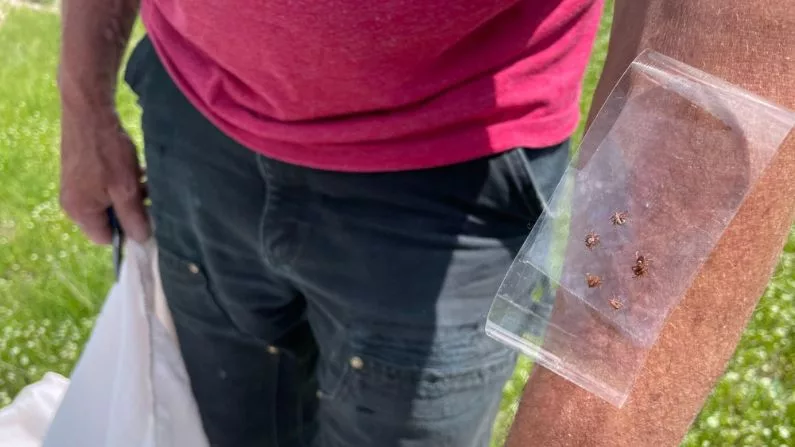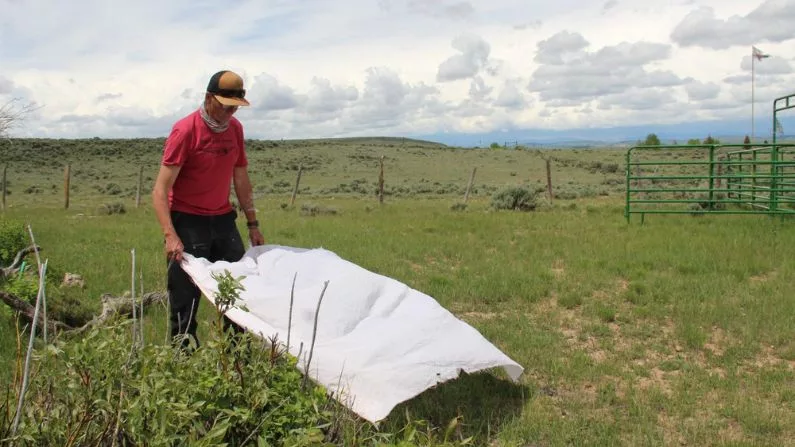This story comes through a content-sharing partnership with Wyoming Public Media.
Walking through the grass and sagebrush on a recent spring day was Sublette County’s local horseshoer, JB. His actual name is James Bond.
“Oh, ‘Double O Seven,’ I mean I’ve been hearing that for 50 years,” Bond said.
But, he is also known by friends as someone who always gets ticks – those creepy, little blood suckers that come out from late March to mid-summer.
“Like, if I’m out walking around with other people, I will find a tick on me or two, and other people don’t,” he said.
This year Bond has had more than usual. Ticks are actually considered the second most ‘dangerous’ creature in the world when it comes to transmitting disease – only behind mosquitoes. And it is not just Bond that has noticed the increase this year. Many are saying that anecdotally it is a big tick year in Western Wyoming, which is especially of concern in Sublette County, where there is the highest rate of tick fever disease in the country.
So, Bond is taking note. He is collecting ticks in his yard to get an idea of how many are out there. He does what actual researchers do, using a white, bed sheet.
“I just have it draped out behind me, but I’m walking backwards and just dragging it slow[ly] by this grass,” he said as he carefully pulled the sheet through his yard.
Ticks will grab onto the sheet, like they do to us. Bond checked it for ticks.
“Here’s one over there and that one,” he said as he pointed to two little, brown ticks. He picked them off the sheet with pliers. “Come on you little devil,” Bond said. And then he stuck them to scotch tape wrapped around his wrist.
He got seven in about 10 minutes. The two days before he got 40. For a short, informal study, there were a lot of ticks.
Scott Schell, an entomologist with the University of Wyoming, had a theory as to why there are so many in Western Wyoming this year. It has to do with over half of some of the mule deer and pronghorn herds dying in Sublette County from the harsh winter.
“There’s still those ticks out there that would have normally been picked up by deer and antelope and elk as they wander around the trails,” Schell said. “If you go out fishing and you’re walking down the trail, you’re its ideal substitute.”
Teton County Weed and Pest’s Mikenna Smith said that is a plausible theory. She said another reason could be the rainy weather.
“Just having a general higher humidity could make them more active,” Smith said.
Smith is studying ticks in Western Wyoming for the first time. Mainly, because there really is not a lot of data on ticks in our area.
“For public health, especially, it’s very important to know what factors could be impacting their survival and their population,” she said.
Smith said some of the only data she could find for the area showed that about one in five ticks carry Colorado Tick Fever in parts of Sublette and Teton counties. While tick fever is not usually deadly, it is like a really bad flu.
“People think of ticks, they think of the East Coast, and they think of Lyme disease,” Smith said. “We don’t have Lymes Disease, but we do have ticks. They are out.”
The Wyoming Department of Health said so far this year there are no reported cases of Colorado Tick Fever in the state. But, in the last 10 years, there were 14 cases in Sublette County, which as mentioned previously, has the highest rate in the country.
And James Bond – the tick catcher – he has had tick fever. He got it in 2003 at his home, and over the years, it made him hyper-aware of ticks.
“So that’s when I started gluing them to a card,” he said. “And then dating them, you know?”

The bottom card is Bond’s ‘tick card’ from this year. The top card is from a couple of the studies he did trying to remove ticks from his yard using the white sheet. (Caitlin Tan/Wyoming Public Media)
He calls it a ‘tick card.’ The rules are the tick has to be on him in the house – outside does not count.
“Put the tick on – he’s trying to crawl away. You put a dab of glue on there. Take a toothpick, push him over into the little puddle superglue, and he’s still crawling away,” Bond explained carefully. “And then you just take a little bit of baking soda, sprinkle it, and it sets up. Like instantly.”
Last year, he had nine ticks on his card. The year before — just three. This year, there are 14 ticks on the white card stock with an almost silver sheen from the glue. Notably, there is still at least another month of tick season. Experts say if the rain continues, it could be even longer.
Now, after all this talk about ticks, you might be feeling itchy – even a little creeped out.
Here is a hot tip from weed and pest: when you get home from being outside, do not throw your clothes straight into the hamper. The ticks will literally come find you. Put them on high in the drier for 10 minutes. It will, “nuke them.”







